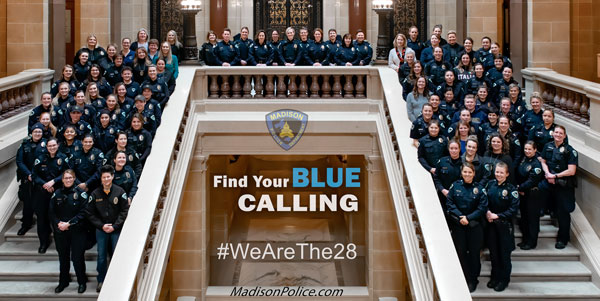I’m Jennifer Krueger-Favour. I am the captain of personnel and training with the Madison Police Department (MPD). I have been a commissioned officer for over twenty-six years now with the MPD. I actually started as a civilian back in 1991 as part of the bicycle pedestrian monitor program, and eventually I took over bicycle licensing for the entire city before I joined the commission ranks and became a police officer in 1992.
My name is Meg Hamilton and I am a sergeant with the Madison Police Department. I’m assigned to the community outreach section, and I’ve been with the MPD since 2007. I worked as a patrol officer for ten years in the south and east districts on the afternoon and overnight shifts. I became a sergeant, or a street-level supervisor, in 2018 and worked overnights downtown prior to moving to the community outreach section.
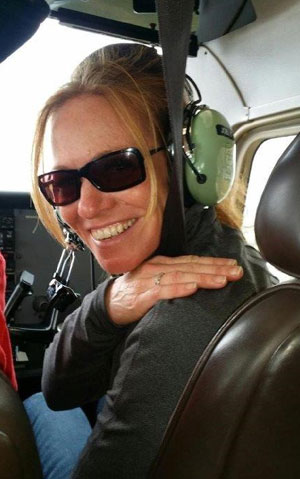
Captain Jennifer Krueger-Favour
The City of Madison Police Department has approximately 489 commissioned officers. We have civilians that also round out our ranks to make us almost six hundred strong. The MPD has always tried to hire a department that reflects the makeup of our community. We have taken it from there and increased the percentage of women in our department to 28%, where it currently stands.
We have also continued to very heavily recruit people of diverse backgrounds to make sure that we mirror what we see in the community and the city of Madison. The national percentage of women across the nation is approximately 12% in law enforcement. The city of Madison has a female population of approximately 28%, which is more than double the national average.
The idea for “We Are The 28” was born in the fall of 2019. One of the community outreach section officers was in a culture work group talking about the continuous improvement of the department, and it was very much part of a conversation about looking deliberately at our culture and using that as a stepping-off point for recruitment and for efforts in retaining folks.
Lore Vang expressed to the culture work group how significant it was to be in a workplace that had this nationally recognized percentage of female officers, and he implored the work group to start putting that forward—to do something with that information beyond it being something that’s referenced through word of mouth and nodded to by other law enforcement agencies.
So Lore, who was assigned to my work unit at that time, brought that conversation back to me and had this vision of creating some kind of outreach effort or some kind of campaign to celebrate and highlight the fact that MPD has this nationally significant percentage of female officers.
Recruiting for Diversity
First of all, we wanted it to recognize and highlight the individual stories of the women who make up our department and then use those individual stories as a platform for recruitment to extend laterally and say, “Look at these extraordinary people who we employ, all of whom are women!” under the banner of saying that the MPD is made up of 28% commissioned female officers.
That’s the theme. All of these women belong to that cohort, but they’re each individuals who bring these significant work histories and life experiences to the table. Each of them can contribute meaningfully to the workforce and to the six-hundred-strong Madison Police Department by virtue of the unique people that they are.
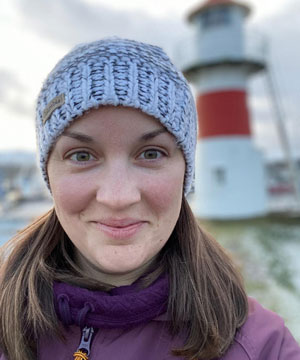
Sergeant Meg Hamilton
So we wanted to put forth those stories and hopefully inspire people who are reading this to say, you know, “Maybe I could be a cop, because her story is similar to mine in this regard,” or, “This person’s narrative resonates with me in a way that I identify with and recognize in myself—perhaps I should be a police officer,” or, “Perhaps I should think about applying to the MPD.” (See how to become a police officer in Wisconsin)
That was the nexus of what we were trying to do: to highlight and celebrate the people that we have and use those amazing stories as a platform to try to get more women in the door. The “We Are The 28” campaign was rolled out on January 1st of 2020. It was a year-long initiative. We were not able to do the in-person event that we had hoped for, so we shifted our focus to doing it entirely online. We made a twelve-month-long effort to highlight individual women in the MPD on social media, tell their stories, and share significant things about them that they feel like define who they are as people. We also included a candid picture of each woman that we profiled out so that the community could see not just a cop in uniform, which carries with it a lot of connotations, but an individual aside from her uniform through all of 2020.
Each month, we tried to focus on a different segment of the police department or different work groups. We also looked to nationally significant months and use that as a platform for the information that we were putting out. For example, we used Mental Health Awareness Month, which was in the spring, to highlight the female members of the Mental Health Unit at the MPD.
We also looked at Women’s History Month and International Women’s Day and developed content specific to that month to specifically be rolled out for International Women’s Day. We utilized Pride Month to recognize one of MPD’s internal groups, the MPD Pride. It’s a work group comprised of LGBTQ+ employees and advocates within the MPD. We also highlighted some of the female members of that group.
Madison Police Department Video
The video that MPD released for International Women’s Day had a theme of “You can be.” Officer Vang spent countless afternoons talking through how to best highlight, in very short vignettes, some of the remarkable personal narratives and characteristics that our female employees bring to the table.
For instance, one of our female neighborhood officers Officer Nieves-Reyes is a veteran. So when she does her vignette, she says, “You can be a veteran,” speaking to her own work history. One of our mounted patrol officers Detective Bland points to the fact that she has a master’s degree and says, “You can have a master’s.”
And we very quickly go through all of these short snippets of personal identifiers from people’s lives, their work histories, and their academic histories. And then at the end, Training Captain Jennifer Krieger-Favor says: “You can be you—that’s who we want. Join the team.” The message that we were hoping would resonate is that the MPD is an inclusive workplace. We want people to bring their individual stories, their personal characteristics, and the things that define them. We want them to bring all of those things to us to make us a more effective, relatable workforce. That was the message that we were trying to convey with a little bit about who we are as an agency and who we’re hoping to attract.
Here is the thirty-two-second long “We Are The 28” video that the MPD rolled out for International Women’s Day 2020.
Detective Amelia Levett

Detective Amelia Levett
My name is Amelia Levett. I am currently a detective with the City of Madison Police Department. I am assigned to the South District General Assignment, so I work all different types of cases in my role as a detective. I’ve been with the Madison Police Department since 2012.
One of the reasons I ended up getting into law enforcement was that when I was in high school, we had to do an internship and I didn’t really know where to do one. I had no idea what I wanted to do—no connections or anything like that. And for whatever reason, my dad actually had a connection with the chief of the Public Safety Department in my hometown. So, he ended up getting me the internship there, and I rode along with the school liaison officer and I just loved it. I loved getting out, talking to people, having autonomy, and not being stuck behind a desk all the time—even though I kind of am now as a detective.
But I just loved every aspect of criminal justice. I was fascinated by crimes, why they happened, and everything like that. So I continued studying criminal justice, and the more I learned about it, the more I felt like this was what I was really meant to do. And I’ve been involved in some way ever since.
When I was a neighborhood officer, in that role, you’re not on the street taking 911 calls as much. It’s more like you’re out in the community getting to know people and following up on cases. But on this day, I heard one of our patrol officer’s dispatch to a check-person call. There was a woman walking in one of our neighborhoods that was running, and she was terrified because there were goats chasing her. And this is in a downtown kind of suburban area.
I love animals, and I decided that I was going to go on this call. So I piped up on the radio and said, “I’m going to take this call for the patrol officer,” who said, “No, no, I got it.” And I actually said, “Nope, trust me, I’ll be out on this one.” So I ended up going out there, and it turned out that it was two baby goats that a farmer had brought over to his father’s house to show him. Their names were Dave and Kevin, and they loved people.
So the baby goats saw this woman walking her dog and wanted to literally go meet them. The farmer turns his back for one minute, and the baby goats are chasing this woman down the street. So I ended up talking to the farmer about the goats. He tells me all about them and he says he was just about to bottle-feed them. I kind of looked at him and there was a pause, and I said, “Did you feed them?” He said, “No, not yet.” And again, I looked at him. There’s a pause, and he says, “Do you want to feed the goats?” And I said, “Absolutely!” So I got to go feed two baby goats that day. That’s one of my favorite stories because it shows you never know what to expect in policing. We can go on traffic stops. We can go on homicides. And then we can go on calls and get to bottle-feed baby goats.
Being part of the “We Are The 28” campaign was pretty amazing for me. I’ve been involved in a program here in Madison called Camp Hero that is a program for girls who want to be involved in the police, fire department, or EMS. I’ve been doing that for about seven years and it’s one of the most rewarding things in my job.
But as part of that, I’ve learned that women are so underrepresented in every first responder job there is, especially policing. So I’ve always been proud that our department has such a large percentage of women. And when Sergeant Hamilton asked if I would be interested in participating in the campaign, I was absolutely overjoyed.
I thought it would be something great to do. And it’s one of the things, too, where when I was first looking into becoming a police officer—I’m only five feet tall, believe it or not; they call me “The Five Feet of Fury” because I’m very small and I’m a female—I thought I couldn’t do it. “I’m too small. I’m not fast enough. I’m not strong enough.” But I realized I could do it, and now I help show other women in this department as well as others that you don’t have to be the biggest, baddest guy to do this job. So being a part of the “We Are The 28” campaign really helped me kind of showcase who I am, my personality.
The specific thing that I was picked for is because I’m crafty. So I say in the video, “You can be crafty—you can do all these things and be a police officer.” I actually embroider pillows; it’s kind of random, but I’m known for that. I made and sold them on Etsy for a while, and I also cross-stitched. That’s one of the things that I do in my free time that sets me apart from a lot of typical police officers, so they highlighted it in the video.
I thought I would never be able to do this job because a lot of time, what I saw on Cops and on TV was your stereotypical big male officer doing
the job. But the more I do this job, the more I see how all different types of people are needed to come out and talk to people in all different types of circumstances, especially on police calls.
So it’s one of those things where a lot of times, I’ll use things about myself—my size, the fact that I’m a female, different experiences that I’ve gone through—to help me on police calls. And I think a lot of times, it really can be a strength. So, I would definitely encourage people to always apply for this job.
If you think you have any head of interest in it, we need all different types of people, and everybody has something to bring to the table. You don’t have to look like that stereotypical cop to do this job.
Investigator Joanna Hollenback
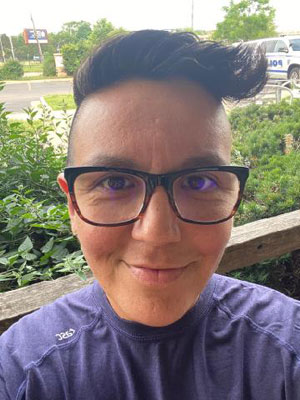
Investigator Joanna Hollenback
My name is Joanna Hollenback. I am an investigator in the Forensic Services Unit of the Madison Police Department. So I am a police officer—it’s a promoted position—and I do crime scene processing. I have been with the police department here in Madison for almost ten years.
I am not from a law enforcement family. I didn’t grow up in one, so it was not anything that was ever on my radar. When I was in my early thirties, I had gone back to finish my bachelor’s degree. I only had twenty-four credits left, and I jumped back in. I was obviously an older returning student and I made a point of getting in touch with my advisor right away because I was a non-traditional student. It was her, my advisor, that actually first suggested that I consider going into policing. She said, “You need to read about the Madison Police Department. They do community policing. I think you’d be a really good fit.”
I did not decide to apply until the final date. I literally waited until that day and then I faxed in my paperwork, because I was old and I didn’t know how to send an electronic form. And I just thought, “Well—we’ll see what happens.” I ended up being sworn in on May 31st with my class of fifteen in 2011. And I haven’t looked back since.
This is my fifth year as an investigator. What we are tasked with in our unit is dealing with assisting patrol in documenting their scene. Sometimes it’s a low-level scene where you have a case of battery and somebody being arrested for having battered someone else, and they need the injuries documented by photographs. I respond to those calls and I take photos of that victim’s injuries to be later used in their case, if necessary.
We also process large scenes. So if we have, for example, a homicide, we go to those scenes as well. We document with photography and with video, we diagram the scenes, and we collect the evidence in conjunction with working with detectives and oftentimes the Violent Crimes Unit.
We go into these scenes and sometimes they are very graphic in nature. They’re always tragic—especially when it’s a homicide, because somebody has lost their life. And our job is to document that scene, to provide the best picture of what happened based on the evidence we’re seeing and what the scene looks like when we arrive. One of the calls that I ended up on was a homicide on the south side of the city late at night. We had two victims shot at a gas station. One passed away at the scene, and the other fortunately survived. But it was a large scene. You had an outdoor scene, because one of the victims was shot outside by the gas pumps, while the other victim went down inside the store. There was lots of damage, broken glass, and blood.
When you have a scene like that—especially one where you have some things inside, there’s some things outside, and then the family starts showing up—you have lots of officers on the scene that are helping manage the perimeter and security, yet I still have a job to do. But you spend a lot of time in those areas where there’s things that normal people don’t ever want to have to see nor should they, and you have a job to do so.
When we go to autopsies, we are dressed in scrubs with the forensic pathologist and the morgue tech. We are in the room as they’re doing the procedure, because any evidence collected from the body is turned over to us and we start that chain of custody, so we are actually present physically in the room or the surgery suite while the procedure is going on.
I was contacted by Sergeant Meg Hamilton, and she said, “Hey, I’m doing this campaign.” And we knew about it because we had seen the blog posts each month with the different themes or officers featured, which I thought was really cool. She said that she’d like to do something about the Forensic Services Unit and asked if any, or all of us, would be interested in doing something.
None of us were really interested to be featured individually in “We Are The 28,” so we bounced back the idea of featuring the group. She was really open to that and just thought it was a great idea. The article about us ran after she had interviewed us, and I thought it was really cool.
I thought it was great that our department was encouraging this campaign. I am really proud to work for an agency that has a relatively high percentage of women in the organization, I thought it was really well done and well written, and it showed a wide variety of the women that work for our organization and where they came from, from all walks of life. I thought it was great to be a part of that.
Police Officer Emily Samson

Police Officer Emily Samson
My name is Emily Samson, and I am a police officer with the City of Madison Police Department. What got me into law enforcement was indecision. Maybe that’s the simplest statement of what influenced my decision to join the Madison Police Department. I graduated from college in 2000 and I didn’t know what to do. I went to the University of Wisconsin Madison and obtained my undergraduate degree in behavioral science and law with another degree in women’s studies.
I wasn’t sure what I wanted to do with myself and my life after college. My older sister by two and a half years had been hired by the Madison Police Department in 1998. And as many little sisters do, I followed in her footsteps. I thought, “Well, if she can do it, I can do it.” And she was having a really good experience, so I thought, “Well, maybe I’ll have a really good experience too.” So I applied to the police department in 2000, and ultimately I was denied. They did not hire me that year.
Being a very competitive individual, that motivated me further. I was not used to very many people saying no to me at that point in my life. And I went after it again; I reapplied. I went through the hiring process again and I was hired as a Madison police officer, making my sister and I the first sisters ever hired by the Madison Police Department.
I am currently assigned to our training team. My primary responsibility as a member of the training team is to help certify our newest police officers. We put our newest police officers, who we refer to as recruits, through an internal police academy. My primary role while they’re with us is to teach them defense and arrest tactics—we refer to it as DAT. DAT is the intervention options, the tools that we can use as police officers to intervene in a situation that requires police response.
So it’s everything from just showing up on a call and using our verbal skills to give people directions to asking or telling people what we need them to do in order to diffuse the situation. It goes all the way through all of our intervention options to the use of deadly force. I am the lead instructor in that topic, and I’m actually the first female officer to be assigned that lead role for our pre-service academy.
As far as calls that stand out in my heart that I remember, there was a death investigation that I responded to very early in my career. I think it was in my second year and I was working the night shift out of the west district, and it was very late into my shift, which was very early in the morning. The alert tones sounded, and the alert tones referred to a call where, most likely, a weapon is involved. And so whenever the alert tones go off, your ears perk up and you pay attention.
Even if it’s four o’clock in the morning and you’re just thinking about trying to get home to go to bed, you refocus and you’re re-energized, and you start thinking about what you need to do in order to respond quickly and safely to whatever is about to get dispatched over the air. And in this particular incident, my coworkers and I were dispatched to a residence where a woman had committed suicide. And what made it kind of noteworthy was that she had used a firearm—that’s not a very common method that women use when they resort to suicide. In responding to the incident, I ended up in the position to be with the woman’s partner, and he was devastated. I was just spending time with him that morning, investigating the incident, which meant that I had to ask him a lot of questions.
That gentlemen was going through such a terrible time, and I had the absolute honor of being the person that was there with him and for him just as that thing had happened to him. It’s not a kind of a privilege that’s ever lost on me. I showed up at a time that I think he will remember. Well, he clearly will never forget it. I always try to work really hard in those moments to make sure that I’m being the best possible police officer and human being that I can be.
I was thrilled being a part of the “We Are The 28” campaign. I am so proud to be a Madison Police Officer, because Madison has always been a leading agency in a lot of different police-related areas, but particularly when it comes to the number of women that are employed as commissioned law enforcement officers.
Officer Fabiola Ortiz

Officer Fabiola Ortiz
I am Officer Ortiz. I work as a patrol officer for the Madison Police Department and am from the class of 2019. I chose law enforcement mainly because of my upbringing. I am a Hispanic American and grew up in a purely Hispanic household. My biological mother is from Mexico, and growing up in our household, we didn’t really have a relationship with law enforcement. There was that understanding that because I have family members who were undocumented immigrants or who came from undocumented immigrants, law enforcement wasn’t really an area of support for us as a community and as a culture. It just was an understanding that if we needed help, we could take care of it.
We didn’t really have any outside help like people who are born here typically do. So I chose law enforcement, and as I started to do my studies or have studies in criminal justice, I came to understand that a lot of those stigmas that I grew up being told were untrue and that a simple law enforcement officer does not have the authority to—nor do they have the desire to—rip families apart, documented or not. So the more that I learned what an actual officer does, the more I chose to educate not only my immediate family but those around me—that law enforcement is a support system that they could have.
I was adopted later by two Caucasians, and going into law enforcement was something that they were not extremely supportive of at the start. They were worried based on me being a female, being smaller in stature, and just the nature of the job, which does entail going head-on into things that people typically run away from.
You could imagine that a parent would be quite surprised that their child would want to do something like that. But they were supportive after some time. I’ve had friends as well say that being a police officer really suits my personality. My biological mother was and always has been very supportive, coming from a family who didn’t really have careers.
Prior to going into law enforcement, I worked as a wildland firefighter. I was based in the state of Oregon and worked as a grounds crew member, which meant that when a natural disaster or man-made fire in the forest occurred, they would call us and we would go to where the fire was and work our way into cutting the fire off from spreading.
Currently, I work as a patrol officer for the Madison Police Department. My role is heavily based on contact with the community. So on a day-to-day basis, I drive a fully marked patrol squad car. I am dressed in full military-style uniform, which makes me easily distinguishable as a patrol officer. I go out either when called by somebody in a crisis or if I self-initiate myself into a patrol call, making contact with the person. What can I do to help this person?
There are several events that share a consistent factor that I particularly enjoy being dispatched to and assisting in. Those types of calls include being able to translate for native Spanish speakers. In Madison, we have pockets of the community or just individuals in the community itself that only speak Spanish. I particularly enjoy being able to communicate with the native Spanish speakers.
I chose law enforcement because I wanted to bridge the gap between the Hispanic culture and Spanish speakers with police officers and law enforcement as a whole. When I go to calls, or as I’ve been dispatched to calls with people who only speak Spanish, they are in the worst day of their lives. Most of the time, it is somebody is in a crisis. I can only imagine if I were in a crisis and I could only speak one language trying to ask for help and not being able to fully explain what I needed help with. I am fluent in Spanish, and having that ability, I can see the look of relief on a person’s face when I show up and I start speaking Spanish to them. It’s almost like they take a second, take a deep breath, and they’re like, “Thank you.”
Being a part of the “We Are The 28” was exciting. It was new to the Madison Police Department. I was able to be on that front line of something that will hopefully grow with other departments.
Patrol Officer Jessica Wolf

Patrol Officer Jessica Wolf
My name is Jessica Wolf, and I am currently employed as a patrol officer with the City of Madison Police Department. I’ve been with them for about five years. I work the 3:00 p.m. to 11:00 p.m. shift and I have had that shift now for going on about four years.
I went to the University of Michigan and I swam there all four years on the University of Michigan women’s team. During my junior year of college, I was thinking and talking with my swim coach trying to figure out what I kind of wanted to do later after college. And ultimately, my coach got an envelope with recruiting information from the Madison Police Department. My swim coach mentioned it to me because I was from Wisconsin originally.
I ended up applying for the Madison Police Department, going on a ride along and really, really wanting to go through the recruiting process where you have to do an interview and pass a physical exam. At that time, I was in tip-top shape, so I didn’t have to worry about anything. Going through the recruiting process made me want to be a police officer even more.
I currently am a patrol officer and in that role, we answer 911 calls. Responding to 911 calls every day, you never know what you’re going into. It could be a shooting where someone’s been shot; it could be a child abuse case where the children have horrific injuries. It can go from a barking dog complaint to a homicide.
One call that I went to that really resonates with me was a woman who called 911 from a parking lot. She was bawling—very upset, very distraught. I knew she was embarrassed to call 911, and she was telling me that this horrible thing happened to her. It took her a lot to come forward and call the police about it. She informed me that this man had assaulted her. I asked if she had any injuries from it, and the injuries she had were significant from what I could see at that point. I took her to our police district station and interviewed her.
She waited to call police because she was just so embarrassed. It was a difficult interview because it was very emotional, but we went through it step-by-step. She went to this friend’s house to get her shoes, and she said that she has used drugs in the past. He is a drug dealer. She wanted to maybe get some drugs, but it escalated to where he didn’t want her to leave anymore. When she was like, “I just want to leave,” he was very angry with her because he was like, “I gave you these drugs, and now you want to leave?” And that’s when he resorted to physically assaulting her. It lasted a long time; he ended up taking a knife and trying to stab her and ultimately gave her a lot of whipping. There were lacerations on her body from a belt. I’ve never seen such an injury so horrible that you could actually see the imprint of the belt. I couldn’t believe how brave she was to come forward. It was a horrific event, and it sat with me for some time.
The “We Are The 28” was kinda neat. I actually got interviewed for it earlier. I was like, “If you’re going to interview, I have to have a picture with my chickens!” So I had a few chickens by my side as I took a photo, but it’s cool because it’s about the woman in our police department, and we’re not a majority here.
Policing has always been kind of a man’s job. And I think it’s neat to be part of a movement, because we have so much to contribute. As woman, we can be strong; we can be brave. But we can also be sensitive and understanding, and maybe sometimes even do our job a little bit better than other people.
Captain Jennifer Krieger-Favor and Sergeant Meg Hamilton
It’s very important for a law enforcement agency to reflect the community they serve, because that’s the people that rely on the officers to assist them in their time of need or to be in their neighborhood forming community relations. It’s many times easier to speak with people that look like you, whether you’re Hmong, Hispanic, African American, if you’re a woman, or if you are part of our LGBTQ community. It’s important to be able to see a reflection in the department, because if you don’t see that reflection, oftentimes people don’t think that they’re getting a fair shake with what’s happening with their case. And when you see that reflection of diversity in the department that reflects the community, then perhaps there can be a greater bond and a greater understanding between what’s going on in the case and with the officers themselves.
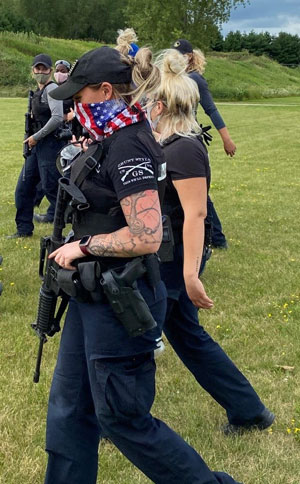
Madison PD Recruit Class
A few weeks ago, I (Sgt. Hamilton) was out working patrol and went to a domestic disturbance. It came in as a couple of 911 calls with someone saying that they needed police right away. I went along with two younger male officers who did an excellent investigation. But in the course of that investigation, the woman that they were interviewing—who in this instance was the victim of a series of violent crimes—looked at me at one point and said, “Could I talk to just you?” and I understood instantly what she wanted.
She was a woman about my age, and there were kids in the household and other family members. And she wanted to talk to me as another woman. That’s not something that a sergeant generally does—take a lengthy interview from a crime victim. But at least in Madison, where we believe in best practices, I absolutely took over.
She wanted to speak to me, and I felt it was because I was a woman and we were close in age to one another. And the male officers in this instance immediately acquiesced because they recognized that it was important to the victim of this crime to talk to someone that she was comfortable with.
I think about how often that happens in the field, how often we have someone who maybe has never had to speak with police before, or who conversely has talked to police a lot, and they see an officer on the call that they trust because of age, because of race, because of orientation, or because of gender identity. And if we can get the victim of a crime to feel comfortable talking about a scary, harrowing, violent, and awful experience in their life so that we, as law enforcement, can fully investigate it and hold the people who have perpetrated those kinds of crimes accountable, that’s a win for the entire community.
It’s important to us as human beings that crime victims and people who have witnessed or have been privy to crime are comfortable—or as comfortable as they can be—reporting what happened to them. I frequently tell people that if you turn on the TV and you see a female officer depicted every single time, she’s with a male officer. We see that in Hollywood; we see that on TV.
Here in Madison, you may call the police and you might have two female patrol officers show up! I have been on a large-scale investigation in which every person who was there—special investigator, detective, sergeant, and patrol officers—were all female. And that’s a powerful legacy to be part of.
Related links:

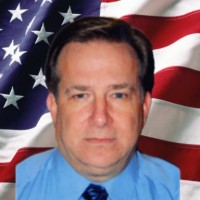 Joseph Libowsky,
Joseph Libowsky,